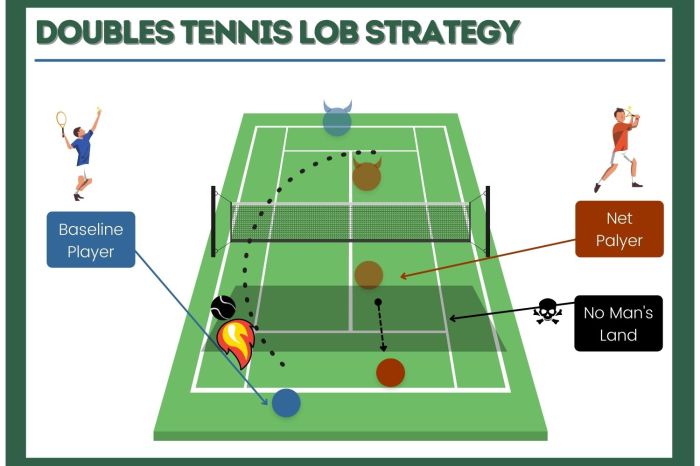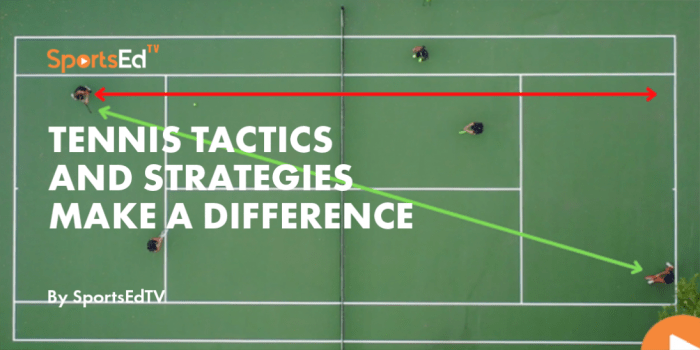Tennis strategies are the secret weapons that can take your game to the next level, whether you’re dominating the court or strategizing your next move. From offensive plays to defensive maneuvers, let’s dive into the world of tennis strategies and unlock the keys to success.
Are you ready to elevate your game and outsmart your opponents? Let’s explore the dynamic and game-changing strategies that can make you a force to be reckoned with on the tennis court.
Tennis Strategies Overview
Tennis strategies are essential in a match as they help players anticipate their opponent’s moves and plan their own tactics accordingly. Having a well-thought-out strategy can make a significant difference in the outcome of a game.
Types of Tennis Strategies
- Baseline Strategy: Players who prefer to stay at the baseline and hit powerful groundstrokes often use this strategy to control the pace of the game.
- Serve and Volley Strategy: This approach involves serving aggressively and following it up by rushing the net to finish points quickly.
- Defensive Strategy: Players who excel in defense focus on retrieving shots and waiting for their opponent to make an error.
Player Strengths and Opponent Weaknesses
- Adapting strategies based on player strengths allows them to capitalize on their abilities, such as a strong forehand or a reliable serve.
- Identifying opponent weaknesses, like a weak backhand or poor movement, can help players adjust their tactics to exploit these vulnerabilities.
Offensive Strategies
When it comes to offensive strategies in tennis, players have a few key tactics they can utilize to gain an advantage over their opponents. These strategies include aggressive baseline play, approaching the net, and using drop shots.
Aggressive Baseline Play
Aggressive baseline play involves hitting powerful shots from the back of the court, putting pressure on your opponent and looking to dictate play. Players who excel in this strategy often have strong groundstrokes and can hit winners from the baseline.
- Players like Rafael Nadal and Serena Williams are known for their aggressive baseline play, using their powerful forehands and backhands to push their opponents deep behind the baseline.
- Aggressive baseline play can be effective against defensive opponents who struggle to handle pace and power.
- However, this strategy can be risky against players with strong defensive skills who can retrieve shots and turn defense into offense.
Approaching the Net
Approaching the net is another offensive strategy where players move forward after hitting a shot, looking to finish points at the net. This strategy can put pressure on opponents and take away time to react.
- Players like Roger Federer and Martina Navratilova are known for their proficiency at the net, using their volleys and touch to finish points quickly.
- Approaching the net can be effective against opponents who struggle with low balls or passing shots under pressure.
- However, approaching the net can be risky against players with strong passing shots who can hit winners when given the opportunity.
Using Drop Shots, Tennis strategies
Drop shots are a strategic way to change the pace of a rally and catch opponents off guard. This offensive strategy involves hitting a soft shot that lands close to the net, forcing opponents to run forward and potentially set up an easy winner.
- Players like Novak Djokovic and Ashleigh Barty are known for their effective drop shots, using them to mix up play and keep opponents guessing.
- Using drop shots can be effective against opponents who struggle with movement or have difficulty handling short balls.
- However, drop shots can be risky if not executed properly, as opponents can anticipate and easily counter them.
Defensive Strategies
When it comes to defensive strategies in tennis, players need to focus on consistency and patience to counter their opponent’s aggressive plays. By mastering defensive techniques like baseline play, lobs, and slices, players can effectively wear down their opponents and wait for the right opportunity to switch to offensive tactics.
Consistent Baseline Play
- Consistent baseline play involves hitting deep shots with good depth and pace to keep the opponent pinned behind the baseline.
- Players should focus on moving their opponent side to side, forcing errors and creating openings for offensive shots.
- By maintaining a solid defensive position and returning shots with accuracy, players can frustrate aggressive opponents and force them into making mistakes.
Defensive Lobs
- Defensive lobs are effective in neutralizing aggressive players who like to attack the net.
- Players can use lobs to buy time, reset the point, and force their opponents to retreat to the baseline.
- Well-executed defensive lobs can disrupt the opponent’s rhythm and create opportunities to counter-attack.
Defensive Slices
- Defensive slices involve using underspin to keep the ball low and force opponents to generate their own pace.
- Players can use slices to change the pace of the game, disrupt the opponent’s timing, and set up offensive opportunities.
- Mastering defensive slices can be a valuable tool in breaking down aggressive opponents who struggle with low balls.
Switching from Defensive to Offensive Tactics
- Knowing when to transition from defensive to offensive tactics is crucial in a tennis match.
- Players should look for opportunities where they can capitalize on a weak shot from their opponent or when they have successfully pushed their opponent out of position.
- Switching to offensive tactics at the right moment can catch the opponent off guard and shift the momentum in the player’s favor.
Serving Strategies

When it comes to tennis, serving strategies play a crucial role in gaining an advantage over your opponent. A strong serve can help you control the pace of the game, set the tone for the point, and even earn you some free points.
Different Types of Serves
- Flat Serve: The flat serve is hit with power and speed, making it difficult for your opponent to return. It is often used as a first serve to start the point aggressively.
- Slice Serve: The slice serve has sidespin that causes the ball to curve away from the opponent, making it tricky to return. It is effective on both first and second serves.
- Kick Serve: The kick serve has topspin that causes the ball to bounce high, making it challenging for your opponent to control the return. It is great for mixing up your serves and keeping your opponent off balance.
Tips to Improve Your Serving Strategies
- Work on Your Toss: A consistent and accurate toss is crucial for a good serve. Practice your toss to ensure you can hit the ball at the right contact point every time.
- Vary Your Serves: Don’t become predictable with your serves. Mix up your flat, slice, and kick serves to keep your opponent guessing and unable to anticipate your next move.
- Focus on Placement: Aim for different areas of the service box to keep your opponent moving and make it harder for them to return your serve effectively.
- Practice Your Second Serve: Your second serve is just as important as your first serve. Work on developing a reliable second serve that has enough spin to land in and keep your opponent under pressure.
Mental Strategies: Tennis Strategies

In tennis, mental strategies play a crucial role in determining a player’s success on the court. These strategies encompass staying focused, managing emotions, and handling pressure effectively.
Developing Mental Toughness
- Practice mindfulness techniques to stay present during matches.
- Visualize success and positive outcomes to boost confidence.
- Utilize deep breathing exercises to stay calm under pressure.
- Set short-term goals to maintain motivation and focus during matches.
Famous Players and Mental Strategies
-
Rafael Nadal’s intense focus and determination have helped him overcome challenges on the court, making him one of the most mentally tough players in tennis history.
-
Serena Williams’ ability to stay composed under pressure and channel her emotions positively has been a key factor in her numerous Grand Slam victories.
-
Novak Djokovic’s mental resilience and ability to bounce back from setbacks have been instrumental in his success on the ATP tour.

